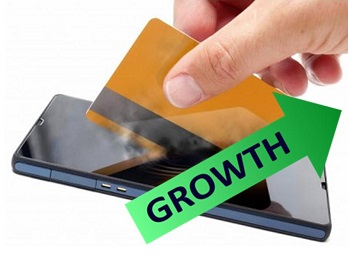Denny |
September 30, 2015
As a rising number of people use their smartphones to make purchases, cyber criminals will up their efforts, too.
According to the results of a recent survey, most cyber security experts (87 percent) now feel that as mobile payments become more popular over the next 12 months, it will also bring about a rise in the number of associated data breaches.
Equally, 42 percent of surveyed cyber security experts had also already used that transaction method this year.
The survey involved the participation of 900 experts in cyber security. It was conducted by ISACA and it suggested that mobile payments are likely to progress without any real barrier from security concerns. Among the respondents to this survey, only 23 percent said that they felt that smartphone payments were actually a safe way to store personal information. Another 47 percent said that they felt that this type of transaction is entirely unsecure. An additional 30 percent of respondents said that they were unsure as to whether or not the transactions were secure.
Regardless of the risk that is associated with security, it looks as though mobile payments are moving ahead.
 Nearly 89 percent felt that cash remains the most secure way for payments transactions to be completed, today. That said, only 9 percent of the respondents said that this was their preferred method of payment.
Nearly 89 percent felt that cash remains the most secure way for payments transactions to be completed, today. That said, only 9 percent of the respondents said that this was their preferred method of payment.
The ISACA survey participants were asked to provide their opinions with regards to the types of vulnerabilities that could be associated with using smartphones to complete payments transactions. Among them, the mobile security concerns that were identified were:
• WiFi – 26 percent
• Loss or theft of the smartphone – 21 percent
• Shmishing (text message phishing)/phishing – 18 percent
• Weak password protection – 13 percent
• User/human error – 7 percent
The report also indicated that mobile payments based on contactless and NFC technology will be continuing their growth. As a whole, the marketplace for these transactions is predicted by Future Market Insights to be worth $2.8 trillion in five years. The cyber security experts felt that the best way to boost the security of the transactions is to use two authentication methods (66 percent) and to require a short-term authentication code (18 percent).
BWild |
September 18, 2015
A recent study has forecasted that within a span of 7 years from now, the industry will reach $3 trillion.
The Bank of America Merrill Lynch has now released a report in which it has stated that in a period of 7 year, mobile payments will have grown by 200 times their previous size and will be worth more than $3 trillion.
If this prediction is correct, then wallet and banking apps, retailers, and telecoms are about to benefit greatly.
The report indicated that those who are most likely to benefit from this growth of mobile payments are: banking, telecom, IT, and mobile wallet firms. The report stated that “In India, we consider mobile payments to be both an opportunity (for banks, telcos and new players) and threat (due to dis-intermediation, more to the traditional banks). We estimate the value of mobile banking, estimated at just USD16 billion today to rise 200x in 7 years to more than USD 3,000 billion.”
It is also expected that mobile payments will make up 10 percent of the total transactions in that country.
 This is quite the increase, considering that for the 2015 financial year, smartphone payments made up only 0.1 percent of the total. The report stated that this will be a considerable opportunity for many companies involved in that industry to better their “competitive positioning.” Equally, the report noted that it would mean that there would suddenly be considerable competition making its way into the space that had previously been held by public sector banks.
This is quite the increase, considering that for the 2015 financial year, smartphone payments made up only 0.1 percent of the total. The report stated that this will be a considerable opportunity for many companies involved in that industry to better their “competitive positioning.” Equally, the report noted that it would mean that there would suddenly be considerable competition making its way into the space that had previously been held by public sector banks.
As the payments technology evolves, it is expected that the use of paper cash will have dropped to under 2 percent. The report predicted that the range of alternative methods of payment will lead to a gradual decrease in the use of cash throughout the economy, and that electronic payments will help to ease the lending rates and will encourage growth over time.
It pointed out that among the primary drivers behind the growth of the use of alternative transactions will be in the improvements of mobile payments through greater smartphone penetration. That penetration in India is expected to double in the country’s young population over the next three years. As 60 percent of the population is younger than 35 years old, this represents a massive shift in digital technology use.
 Nearly 89 percent felt that cash remains the most secure way for payments transactions to be completed, today. That said, only 9 percent of the respondents said that this was their preferred method of payment.
Nearly 89 percent felt that cash remains the most secure way for payments transactions to be completed, today. That said, only 9 percent of the respondents said that this was their preferred method of payment.
 This is quite the increase, considering that for the 2015 financial year, smartphone payments made up only 0.1 percent of the total. The report stated that this will be a considerable opportunity for many companies involved in that industry to better their “competitive positioning.” Equally, the report noted that it would mean that there would suddenly be considerable competition making its way into the space that had previously been held by public sector banks.
This is quite the increase, considering that for the 2015 financial year, smartphone payments made up only 0.1 percent of the total. The report stated that this will be a considerable opportunity for many companies involved in that industry to better their “competitive positioning.” Equally, the report noted that it would mean that there would suddenly be considerable competition making its way into the space that had previously been held by public sector banks.